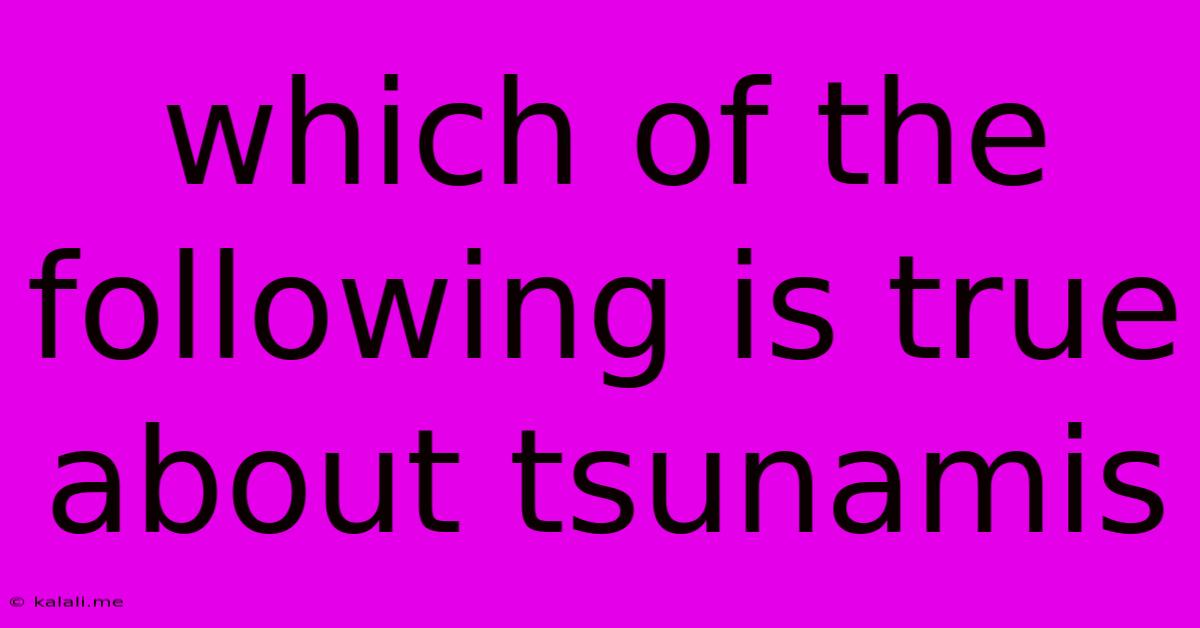Which Of The Following Is True About Tsunamis
Kalali
Jun 14, 2025 · 3 min read

Table of Contents
Which of the Following is True About Tsunamis? Debunking Common Myths and Understanding the Science
Tsunamis, often mistakenly referred to as tidal waves, are devastating natural disasters capable of inflicting widespread destruction and loss of life. Understanding their nature is crucial for preparedness and effective mitigation strategies. This article will address common misconceptions and delve into the scientific truths surrounding these powerful oceanic events. We'll explore what is true about tsunamis, separating fact from fiction.
What are Tsunamis?
Before exploring the truths about tsunamis, it's essential to define them. A tsunami is a series of extremely long waves caused by a large and sudden displacement of the ocean, typically resulting from underwater earthquakes. Other potential causes include volcanic eruptions, underwater landslides, and even meteorite impacts. Unlike typical ocean waves generated by wind, tsunamis possess immense wavelength and energy, capable of traveling across vast distances at incredible speeds.
Debunking Myths and Unveiling the Truth:
Many misconceptions surround tsunamis. Let's examine some common statements and determine their accuracy:
Myth 1: All underwater earthquakes cause tsunamis.
Truth: While underwater earthquakes are the most common cause, only those of sufficient magnitude and occurring on a fault line that vertically displaces the ocean floor generate tsunamis. Smaller earthquakes or those with primarily horizontal movement rarely produce tsunamis. The size and type of tectonic shift are critical factors.
Myth 2: Tsunamis are single, massive waves.
Truth: Tsunamis are typically a series of waves, with the initial wave not always being the most destructive. The waves can arrive minutes or even hours apart, leading to a false sense of security after the first wave. Subsequent waves can be significantly larger and more powerful. This characteristic is often overlooked, contributing to the devastating impact.
Myth 3: Tsunamis are only dangerous in coastal regions.
Truth: While coastal regions are most vulnerable to the destructive power of the waves, the initial tsunami wave can travel far inland, inundating low-lying areas and causing significant damage miles from the shoreline. The run-up, or the maximum vertical height reached by the wave on land, can be exceptionally high.
Myth 4: You can outrun a tsunami.
Truth: This is unequivocally false. Tsunamis travel at incredibly high speeds in the open ocean. Once a tsunami nears the coast, its speed slows, but its height and power increase dramatically. Evacuation to higher ground is the only effective way to avoid the destructive force of a tsunami.
Myth 5: All tsunamis are easily predictable.
Truth: While scientists utilize advanced monitoring systems to detect earthquakes and predict potential tsunami threats, accurately predicting the exact timing, size, and impact zone of a tsunami remains challenging. Early warning systems provide valuable time for evacuation, but they are not foolproof. Ongoing research is focused on improving prediction accuracy.
Conclusion:
Understanding the true nature of tsunamis—their causes, characteristics, and potential impact—is crucial for effective disaster preparedness and mitigation. By separating fact from fiction, we can better prepare ourselves and our communities to face these devastating natural phenomena. Remember, awareness, preparedness, and timely evacuation are our best defenses against the destructive power of a tsunami.
Latest Posts
Latest Posts
-
What Organelle Has Its Own Dna
Jun 14, 2025
-
College Of The Ozarks Application Deadline
Jun 14, 2025
-
Which Option Is A Renewable Resource
Jun 14, 2025
-
Least Common Multiple Of 6 8 And 15
Jun 14, 2025
-
One Gram Of Fat Provides How Many Calories
Jun 14, 2025
Related Post
Thank you for visiting our website which covers about Which Of The Following Is True About Tsunamis . We hope the information provided has been useful to you. Feel free to contact us if you have any questions or need further assistance. See you next time and don't miss to bookmark.